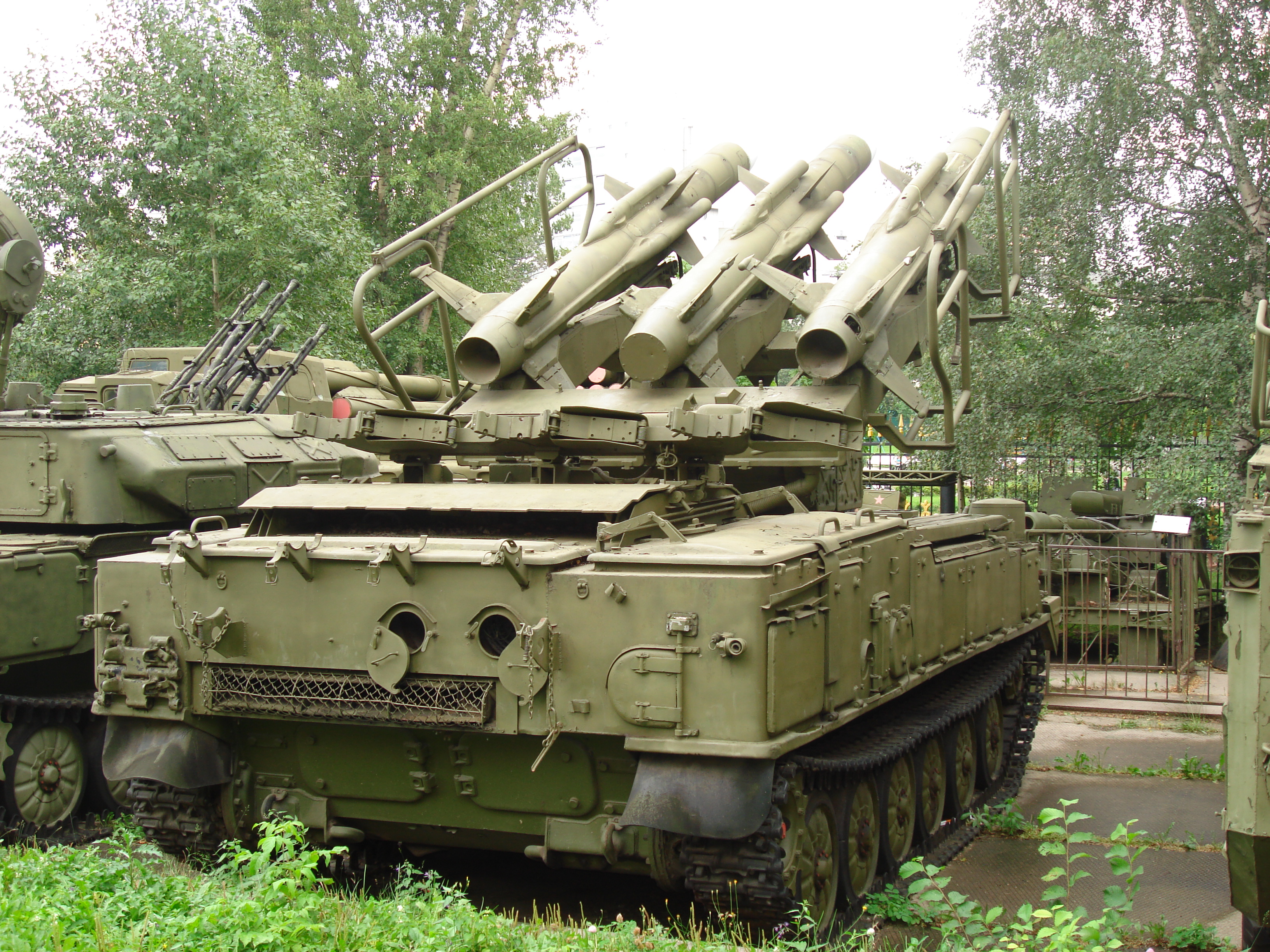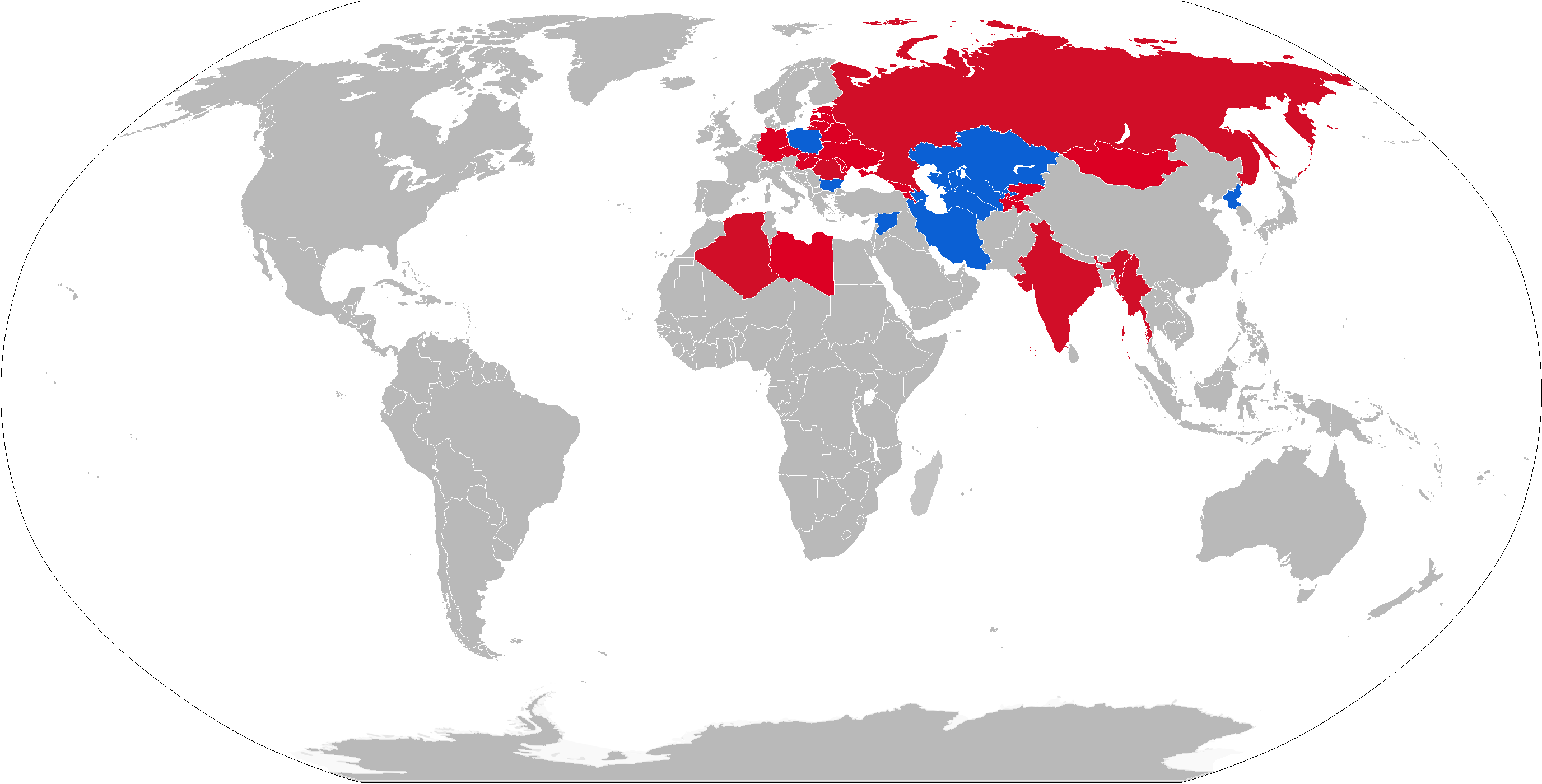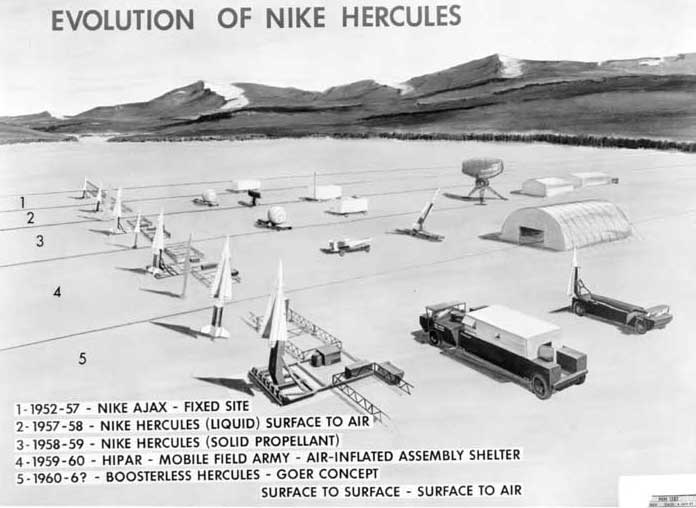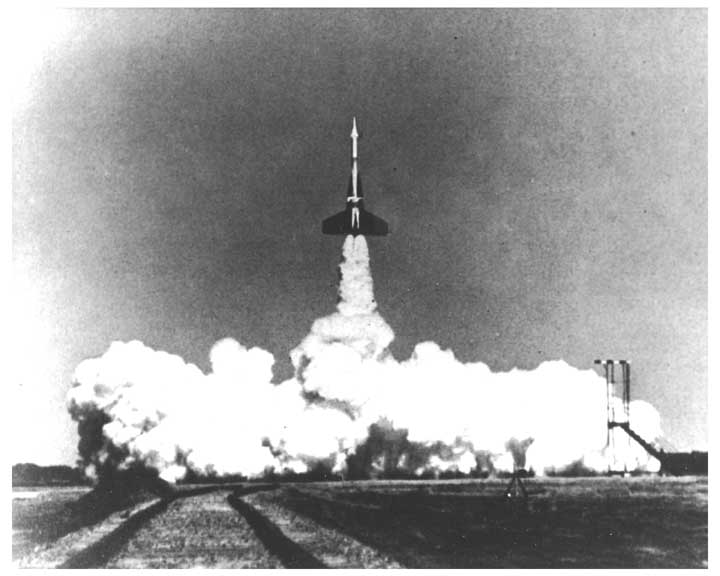|
Command Guided
Command guidance is a type of missile guidance in which a ground station or aircraft relay signals to a guided missile via radio control or through a wire connecting the missile to the launcher and tell the missile where to steer to intercept its target. This control may also command the missile to detonate, even if the missile has a fuze. Typically, the system giving the guidance commands is tracking both the target and the missile or missiles via radar. It determines the positions and velocities of a target and a missile, and calculates whether their paths will intersect. If not, the guidance system will relay commands to a missile, telling it to move the fins in a way that steers in the direction needed to maneuver to an intercept course with the target. If the target maneuvers, the guidance system can sense this and update the missiles' course continuously to counteract such maneuvering. If the missile passes close to the target, either its own proximity or contact fuze will de ... [...More Info...] [...Related Items...] OR: [Wikipedia] [Google] [Baidu] |
Missile Guidance
Missile guidance refers to a variety of methods of guiding a missile or a guided bomb to its intended target. The missile's target accuracy is a critical factor for its effectiveness. Guidance systems improve missile accuracy by improving its Probability of Guidance (Pg). These guidance technologies can generally be divided up into a number of categories, with the broadest categories being "active", "passive", and "preset" guidance. Missiles and guided bombs generally use similar types of guidance system, the difference between the two being that missiles are powered by an onboard engine, whereas guided bombs rely on the speed and height of the launch aircraft for propulsion. History The concept of unmanned guidance originated at least as early as World War I, with the idea of remotely guiding an airplane bomb onto a target, such as the systems developed for the R.F.C. World War I Drone Weapons, first powered drones by Archibald Low (The Father of Radio Guidance). In World War ... [...More Info...] [...Related Items...] OR: [Wikipedia] [Google] [Baidu] |
S-25 Berkut
The S-25 ''Berkut'' (russian: С-25 «Беркут»; "Berkut" means golden eagle in English) is a surface-to-air guided missile, the first operational SAM system in the Soviet Union. In the early 1950s it was tested at Kapustin Yar. It was deployed in several rings around Moscow starting in 1955 and became combat ready in June 1956. It was used only defensively at Moscow; the more mobile S-75 (SA-2 Guideline) would be used in almost all other locations. Several improvements were introduced over its long service lifetime, and the system was finally replaced by the S-300P in 1982. Its NATO reporting name is SA-1 ''Guild''. S-25 is short for ''Systema 25'', referring to the entire system of missiles, radars, and launchers. Portions of the system include the V-300 missile, R-113 and B-200 radars, and A-11/A-12 antennas for the B-200. History Development of the S-25 was authorized on 9 August 1950 by a decision of USSR and was appended by Stalin: (''We have to get the missile for a ... [...More Info...] [...Related Items...] OR: [Wikipedia] [Google] [Baidu] |
2K12 Kub
The 2K12 ''"Kub"'' (russian: 2К12 "Куб"; en, cube) (NATO reporting name: SA-6 "Gainful") mobile surface-to-air missile system is a Soviet low to medium-level air defence system designed to protect ground forces from air attack. "2К12" is the GRAU designation of the system. Each 2K12 battery consists of a number of similar tracked vehicles, one of which carries the 1S91 (SURN vehicle, NATO designation "Straight Flush") 25 kW G/ H band radar (with a range of ) equipped with a continuous wave illuminator, in addition to an optical sight. The battery usually also includes four triple-missile transporter erector launchers (TELs), and four trucks, each carrying three spare missiles and a crane. The TEL is based on a GM-578 chassis, while the 1S91 radar vehicle is based on a GM-568 chassis, all developed and produced by MMZ. Development The development of the 2K12 was started after 18 July 1958 at the request of the CPSU Central Committee. The system was set the require ... [...More Info...] [...Related Items...] OR: [Wikipedia] [Google] [Baidu] |
S-200 (missile)
The NPO Almaz S 200 ''Angara/Vega/Dubna'' (Russian С-200 Ангара/Вега/Дубна), NATO reporting name SA-5 '' Gammon'' (initially ''Tallinn''), is a long range, high altitude surface-to-air missile (SAM) system developed by the Soviet Union in the 1960s to defend large areas from high-altitude bombers or other targets. In Soviet service, these systems were deployed primarily on the battalion level, with six launchers and a fire control radar. The S-200 can be linked to other, longer-range radar systems. Description The S-200 surface-to-air missile system was designed for the defense of the most important administrative, industrial and military installations from all types of air attack. The S-200 is an all-weather system that can be operated in various climatic conditions. By 1966, the S-200 was officially accepted into service in order to replace the failed anti-ballistic missile RZ-25/5V11 "Dal". The Dal was assigned the NATO reporting name SA-5 "Griffon" bef ... [...More Info...] [...Related Items...] OR: [Wikipedia] [Google] [Baidu] |
SARH
Semi-active radar homing (SARH) is a common type of missile guidance system, perhaps the most common type for longer-range air-to-air and surface-to-air missile systems. The name refers to the fact that the missile itself is only a passive detector of a radar signal— provided by an external ("offboard") source—as it reflects off the target (in contrast to active radar homing, which uses an active radar transceiver). Semi-active missile systems use bistatic continuous-wave radar. The NATO brevity code for a semi-active radar homing missile launch is Fox One. Concept The basic concept of SARH is that since almost all detection and tracking systems consist of a radar system, duplicating this hardware on the missile itself is redundant. The weight of a transmitter reduces the range of any flying object, so passive systems have greater reach. In addition, the resolution of a radar is strongly related to the physical size of the antenna, and in the small nose cone of a miss ... [...More Info...] [...Related Items...] OR: [Wikipedia] [Google] [Baidu] |
Active Radar Homing
Active radar homing (ARH) is a missile guidance method in which a missile contains a radar transceiver (in contrast to semi-active radar homing, which uses only a receiver) and the electronics necessary for it to find and track its target autonomously. The NATO brevity code for an air-to-air active radar homing missile launch is fox three. Advantages There are two major advantages to active radar homing: * As the missile is tracking the target it is going to be much closer to the target than the launching platform during the terminal phase, thus the missile's tracking can be much more accurate and better resistant to electronic countermeasures. Active radar homing missiles have some of the best kill probabilities, along with missiles employing track-via-missile guidance. * Because the missile is totally autonomous during the terminal phase, the launch platform does not need to have its radar enabled at all during this phase, and in the case of a mobile launching platform ... [...More Info...] [...Related Items...] OR: [Wikipedia] [Google] [Baidu] |
Surface-to-air Missile
A surface-to-air missile (SAM), also known as a ground-to-air missile (GTAM) or surface-to-air guided weapon (SAGW), is a missile designed to be launched from the ground to destroy aircraft or other missiles. It is one type of anti-aircraft system; in modern armed forces, missiles have replaced most other forms of dedicated anti-aircraft weapons, with anti-aircraft guns pushed into specialized roles. The first attempt at SAM development took place during World War II, but no operational systems were introduced. Further development in the 1940s and 1950s led to operational systems being introduced by most major forces during the second half of the 1950s. Smaller systems, suitable for close-range work, evolved through the 1960s and 1970s, to modern systems that are man-portable. Shipborne systems followed the evolution of land-based models, starting with long-range weapons and steadily evolving toward smaller designs to provide a layered defence. This evolution of design increasin ... [...More Info...] [...Related Items...] OR: [Wikipedia] [Google] [Baidu] |
Akash (missile)
Akash (IAST: Ākāśa, ) is a medium-range mobile surface-to-air missile (SAM) system developed by the Defence Research and Development Organisation (DRDO) and produced by Bharat Dynamics Limited (BDL). Surveillance and Fire control radar, tactical control and command center and missile launcher are developed by Bharat Electronics (BEL), Tata Power Strategic Engineering Division and Larsen & Toubro.AKASH AIR DEFENSE WEAPON SYSTEM The Akash missile system can target aircraft up to away. It has the capability to neutralise aerial targets like fighter jets, cruise missiles and air-to-surface missiles as well as |
Nike Zeus
Nike Zeus was an anti-ballistic missile (ABM) system developed by the US Army during the late 1950s and early 1960s that was designed to destroy incoming Soviet intercontinental ballistic missile warheads before they could hit their targets. It was designed by Bell Labs' Nike team, and was initially based on the earlier Nike Hercules anti-aircraft missile. The original, Zeus A, was designed to intercept warheads in the upper atmosphere, mounting a 25 kiloton W31 nuclear warhead. During development, the concept changed to protect a much larger area and intercept the warheads at higher altitudes. This required the missile to be greatly enlarged into the totally new design, Zeus B, given the tri-service identifier XLIM-49, mounting a 400 kiloton W50 warhead. In several successful tests, the B model proved itself able to intercept warheads, and even satellites. The nature of the strategic threat changed dramatically during the period that Zeus was being developed. Originally ex ... [...More Info...] [...Related Items...] OR: [Wikipedia] [Google] [Baidu] |
Nike Hercules
The Nike Hercules, initially designated SAM-A-25 and later MIM-14, was a surface-to-air missile (SAM) used by U.S. and NATO armed forces for medium- and high-altitude long-range air defense. It was normally armed with the W31 nuclear warhead, but could also be fitted with a conventional warhead for export use. Its warhead also allowed it to be used in a secondary surface-to-surface role, and the system also demonstrated its ability to hit other short-range missiles in flight. Hercules was originally developed as a simple upgrade to the earlier MIM-3 Nike Ajax, allowing it to carry a nuclear warhead in order to defeat entire formations of high-altitude supersonic targets. It evolved into a much larger missile with two solid fuel stages that provided three times the range of the Ajax. Deployment began in 1958, initially at new bases, but it eventually took over many Ajax bases as well. At its peak, it was deployed at over 130 bases in the US alone. Hercules was officially refer ... [...More Info...] [...Related Items...] OR: [Wikipedia] [Google] [Baidu] |
MIM-3 Nike Ajax
The United States Army's Nike Ajax was the world's first operational guided surface-to-air missile (SAM), entering service in 1954. Nike Ajax was designed to attack conventional bomber aircraft flying at high subsonic speeds and altitudes above . Nike was initially deployed in the US to provide defense against Soviet bomber attacks, and was later deployed overseas to protect US bases, as well as being sold to various allied forces. Some examples remained in use until the 1970s. Originally known simply as Nike, it gained the Ajax as part of a 1956 renaming effort that resulted from the introduction of Hercules. It was initially given the identifier SAM-A-7 (Surface-to-air, Army, design 7) as part of an early tri-service identification system, but later changed to MIM-3 (Mobile Interceptor Missile, design 3) in 1962.Nike was initially designated SAM-G-7, and later changed to SAM-A-7. Originally the Air Force used A while the Army used G, but the Air Force abandoned the 1947 tri-se ... [...More Info...] [...Related Items...] OR: [Wikipedia] [Google] [Baidu] |
2K11 Krug
The 2K11 ''Krug'' (russian: 2К11 «Круг»; en, circle) is a Soviet and now Russian medium-range, medium-to-high altitude surface-to-air missile (SAM) system. The system was designed by NPO Novator and produced by Kalinin Machine Building Plant. Its GRAU designation is "2K11." Its NATO reporting name is SA-4 '' Ganef'', after the Yiddish word meaning "thief"; the name was used because the system was a copy of the Bristol Bloodhound. Development and service Development of the Krug ZRK-SD (2K11) air defense system started in 1957 by the Lyulev OKB design bureau. It was first displayed during a parade in Moscow in May 1965. The system started to be fielded in 1967 and became fully operational in 1969. It was used by the Soviet Army as a long-range SAM. The early version of the Krug entered service in 1965. The first operational deployment version, the Krug-A, entered service in 1967, with extensively modified versions, the Krug-M in 1971 and the Krug-M1 in 1974, which were ... [...More Info...] [...Related Items...] OR: [Wikipedia] [Google] [Baidu] |
.jpg)










